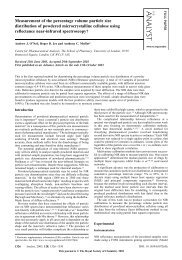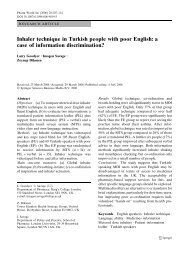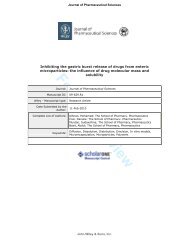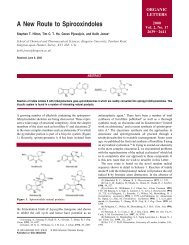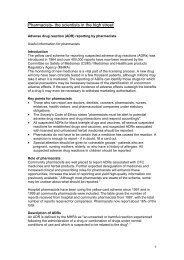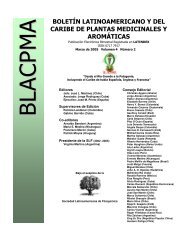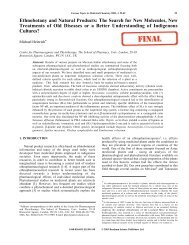SynArfGEF is a guanine nucleotide exchange ... - Pharmacy Eprints
SynArfGEF is a guanine nucleotide exchange ... - Pharmacy Eprints
SynArfGEF is a guanine nucleotide exchange ... - Pharmacy Eprints
You also want an ePaper? Increase the reach of your titles
YUMPU automatically turns print PDFs into web optimized ePapers that Google loves.
Oberkochen, Germany) using x20 and x63 plan-apochromat objective lens. The brightness and<br />
contrast of the final images were adjusted using Photoshop CS4 software (Adobe Systems). In<br />
control experiments, the primary antibody was pre-incubated with the antigen (10 µM) before<br />
immunostaining.<br />
Yeast two-hybrid assay<br />
Yeast two-hybrid screening was performed as described previously (Sakagami et al. 2008,<br />
Sakagami et al. 2007). Briefly, approximately 2 x 106 clones of a mouse brain cDNA library were<br />
screened using pDBLeu-synArfGEF(1122-1194), which encoded the fusion protein of C-terminal<br />
73 amino acids of rat synArfGEF to the GAL4 DNA-binding domain, by the ability to grow on<br />
selective medium lacking h<strong>is</strong>tidine, leucine and tryptophan supplemented with 10 mM 3-<br />
aminotriazole. Positive colonies were further selected by the β-galactosidase assay and uracil<br />
prototrophy. Plasmids were subjected to the sequencing analys<strong>is</strong>. To verify the interaction, the<br />
yeast strain MaV203 was co-transformed with the indicated combination of bait pDBLeu and prey<br />
pPC86 vectors shown in Figs 6 and 7. The interactions were tested by the β-galactosidase assay<br />
and the ability to grow without h<strong>is</strong>tidine and uracil.<br />
In vitro binding assay<br />
COS-7 cells were transiently transfected with various plasmid constructs myc-tagged S-SCAM or<br />
FLAG-synArfGEF and lysed in the lys<strong>is</strong> buffer cons<strong>is</strong>ting of 50 mM Tr<strong>is</strong>-HCl (pH 7.5), 150 mM<br />
NaCl, 1% Nonidet P-40 and a cocktail of protease inhibitors (Complete MiniTM, Roche). Lysates<br />
were incubated with 15 µg of GST, GST-synArfGEF 1122-1194, GST-utrophin 2691-3429, 2691-<br />
3058, 2691-2843, 2937-3685, or GST-dystrophin 2937-3685, immobilized on glutathione-<br />
Sepharose 4B for 1 h at 4°C. Afterwards, the beads were washed five times with the lys<strong>is</strong> buffer<br />
containing 150 mM or 300 mM NaCl and the proteins were eluted with SDS sample buffer. The cell<br />
lysates and eluates were analyzed by Western blot analys<strong>is</strong> with anti-myc IgG or anti-FLAG IgG.<br />
For pull down assays from brain extracts, mouse brains were homogenized with 10 volumes of the<br />
lys<strong>is</strong> buffer and centrifuged at 12000g for 15 min. The supernatant (1 mg) were pre-cleaned with<br />
glutathione-Sepharose 4B for 30 min and incubated with 20 µg of GST, GST-utrophin 2691-3429,<br />
or GST-dystrophin 2937-3685, which were immobilized on glutathione-Sepharose 4B, for 1 h at<br />
4°C. The precipitates were washed with the lys<strong>is</strong> buffer containing 150 mM or 300 mM NaCl and<br />
subjected to Western blot analys<strong>is</strong> with rabbit anti-synArfGEF IgG.<br />
Immunoprecipitation<br />
Immunoprecipitation from brain lysates was performed as described previously (Sakagami et al.<br />
2008). Briefly, the mouse brain P2 fraction was solubilized with 1% sodium deoxycholate in 50 mM<br />
Tr<strong>is</strong>-HCl (pH 9.0) and dialyzed against the binding buffer (0.1% Triton X-100, 50 mM Tr<strong>is</strong>-HCl (pH<br />
7.4)). After pre-cleaning with Protein G-Sepharose 4B, the soluble supernatant (1 mg) was<br />
incubated with 5 µg of anti-synArfGEF IgG or normal rabbit IgG for 1 h at 4oC and with Protein G-<br />
sepharose 4B for another 1 h. The beads were washed five times with the binding buffer plus 150



